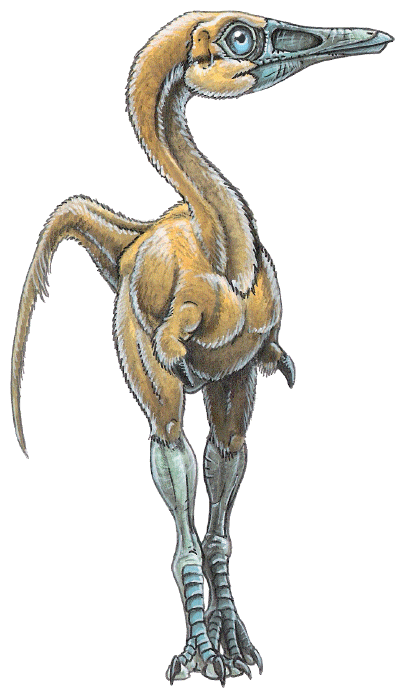|

|
|
Shuvuuia deserti
(Chiappe, et al. 1998) |
|
 |
|
Name Means: |
Desert Bird |
Length: |
3 foot |
|
Pronounced: |
shu-VOO-ee-a |
Weight: |
5.5 pounds |
|
When it lived: |
Late Cretaceous - 85-75 MYA |
|
|
|
Where found: |
Mongolia's Gobi Desert |
|
|
|
Shuvuuia deserti may be the best
known alvarezsaurid, because it is the only one to have fossils that
include complete and well-preserved
skulls.
The Shuvuuia story begins in 1987 when a joint Soviet-Mongolian
expedition found remains of a bipedal dinosaur similar to
Velociraptor, which had also been found in the Gobi Desert. This
newly discovered dinosaur lived around the same as Velociraptor, but
was much smaller - about the size of a turkey. Then, in 1992, an
expedition team from the American Museum of Natural History and the
Mongolian Academy of Sciences discovered more remains of the same
animal, which included two skulls. Although Shuvuuia looked like
a dinosaur, examination of the skulls showed that it had a pointed
beak filled with tiny teeth. The most amazing thing is that it could raise its upper jaw, with respect to the braincase.
This is a characteristic of modern birds. The skulls show that
it more closely related to modern birds than is the famous first bird,
Archaeopteryx.
But that's where the similarity stopped. Shuvuuia’s forelimbs were
short and stubby like ostrich or emu. They were very strong, but
certainly unsuitable for flight. If
it had feathers, then they were not preserved. Unable to fly, this
carnivore was about the size of a turkey. It's long legs indicated
that it was fast runner. Known theropods had three claws, but Shuvuuia
had but one. at the
end of each arm was a single large, hooked claw,
bearing a resemblance to a scythe. It's use has the subject of great
debate. The claws may have been used to catch prey or ward away
small predators. It
is most likely that Shuvuuia was an insectivore, and used its claws to
tear open tree bark or termite mounds to find insects. |
 |
|
Found in Mongolia's Gobi desert, the
strange Shuvuuia (an alvarezsaurid like Mononykus) has been the source
of debate for a long time. Can alvarezsaurids be formally classified
as "Aves"? Are they just dinobirds(redundant as it sounds)? Or are
they, as Paul Sereno proposes in "New Perspectives on the Origin and
Early Evolution of Birds. Ostrom Symposium", modified ornithomimids?
Until recently alvarezsaurids were reconstructed with smaller heads.
This reconstruction is based on the latest Paul Sereno's paper where
he shows an incredibly detailed and complete head that actually is
bigger than thought before. Mary Schweitzer has made an important
study of the "dino fuzz" fossilised integument found with the specimen
and arrived to the conclusion that the main chemical component is
Beta-Keratin: Important demonstration that "dino fuzz" is in reality
feathers. The forelimbs have been a double source of puzzlement:
Extremely short and stout with just one big first claw and the
atrophied remnants of the other two digits: They must have had a very
specific function. Nick Longrich did a presentation at the last two
Society of Vertebrate Paleontology meetings on Shuvuuia and the
closely related Mononykus concluding that they could have been ant or
termite feeders (as it is shown here). Termite mounds are known as far
back as the Triassic, so it is a distinct possibility although we
might never know for sure. |
|
|
|
|
|
|
|
|
Edugraphics.Net | Feenixx Publishing |
|
|
|
|
|
![]()

